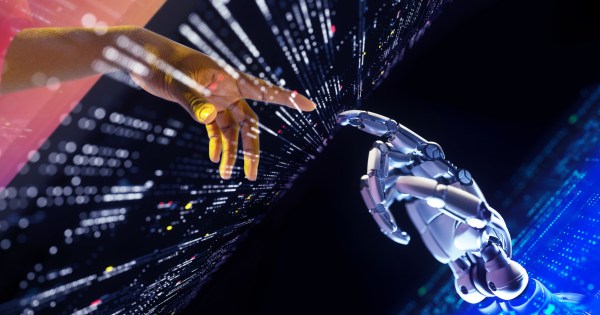But while this icy palette remains popular, it does not reflect people’s actual relationship with technology. According to Getty Images’ VisualGPS AI report, 98% of consumers say authentic visuals are pivotal to building trust, which means beating the “tech blues” may be the key to connecting with today’s audiences.
A brief history of the tech blues
One of the most iconic scenes in science fiction cinema, the finale of Blade Runner (1982), is almost monochromatically blue: The scene is awash in blue lighting; dystopian Los Angeles is blue neon and blue-black skyscrapers; Roy Batty’s eyes gleam an icy, unnatural blue, signaling his mechanical nature as a replicant. Blade Runner preluded the internet era of sci-fi film, but its visual legacy would endure, joining other canonical sci-fi titles like The Matrix to establish a visual language for technology.
Real-life technology also plays a role in shifting tech aesthetics. With the advent of the internet alongside advancements in CGI and special effects, the tech blues became more deeply associated with visualizations of the future.
At the same time, brands in the 1990s were focused on broad, generic appeal, and depictions of technology coalesced around the recognizable aesthetic from the movies. Blue tones cast the future as something cold and meticulously calculated. Environments were medicinal and minimalist; they evoked a kind of masculine angularity, following the lineaments of circuitry and hardware.
This would cement the aesthetics of tech for decades to come—not just in marketing, but in the development of technology itself. Our everyday devices became sleeker, thinner, more portable. User interfaces on smartphones and computers became more minimalist with each software update.
Not until the 2010s was there a shift to bring other tones into the futuristic palette. The injection of pinks and purples into the blues, often called “bisexual lighting,” afforded a warming, more inclusive quality to technological imagery. In terms of composition, images featuring people using technology, rather than just the technology itself, became more popular.
Now, we’re facing another technological revolution. Artificial intelligence—specifically generative AI—is everywhere. What was once a trope of science fiction is now on course to be the defining technology of this century, and naturally, enthusiasm around AI has led to a strong reemergence of the tech blue aesthetic.


